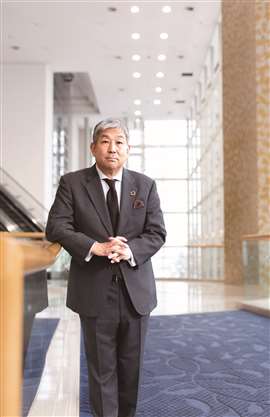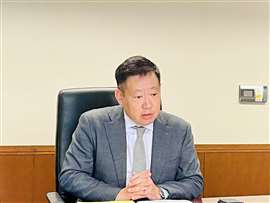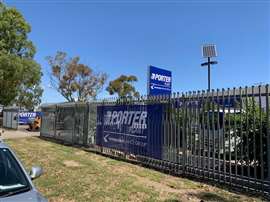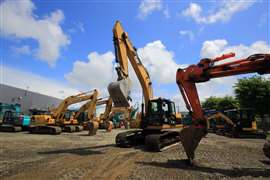Read this article in French German Italian Portuguese Spanish
Interview: Kanamoto’s plans for overseas expansion
22 April 2024
Tetsuo Kanamoto, president of Kanamoto and Hideaki Yamashita, overseas business division manager, talk plans for overseas expansion, tackling the energy transition, and technology utilisation.
 Tetsuo Kanamoto, president of Kanamoto
Tetsuo Kanamoto, president of Kanamoto
A conversation with Tetsuo Kanamoto, president and CEO of Japan-based rental company Kanamoto certainly paints a clear picture as to the future ambitions of the company.
Mr Kanamoto, an industry veteran who has spent 41 years of his career with the company, the last eight of which he has held the top job, has seen both the good and bad that the rental market has to offer.
Under his stewardship, the company has continued to venture further out from its native Japan in search of new revenue streams and is now active in Australia, China, Indonesia, Thailand, Vietnam, Philippines and Malaysia.
There are of course two significant markets that have remained untapped by the company: North America and Europe.
However, that could be about to change as the company aims to solidify itself as one of the top five rental companies in the world.
Speaking to IRN about the plans at the end of March, Mr Kanamoto revealed a potential ground-breaking move into North America; “To be top five I think we need to be in the North American market, which is very attractive. We’ve already begun a feasibility study to look into that and we’re looking into the US in depth.”
“We can’t say right now if we are interested in any particular region, but we’re taking a deep dive into the market.”
He says the company is taking a cautious approach, highlighting the unpredictability of US politics and exchange rates making it “not an ideal time to go shopping.”
“We will keep an eye on that and make sure that if we make a move, we’ll make a move at the right time.
“If a suitable candidate does appear, then we might be up for the challenge.”
As for its plans to break into the top five global players, which would be driven by expansion abroad, Hideaki Yamashita, overseas business division manager, says the company is aiming to more than double overseas sales ratio over the next six years.
He says, “The aim is that 10% of group sales will come from our overseas business in five years’ time.
“If Kanamoto’s sales are ¥200 billion (€1.22 billion), ¥20 billion (€122 million) of that will be from our overseas. Right now, it’s around the ¥10 billion (€61 million) mark, which is less than 5%.”
Japan’s rental market
Mr Kanamoto also gives a good overview as to current state of equipment rental and wider construction sector in Japan.
While supply chain disruptions, an undervalued Yen, economic downturns and lasting effects of the pandemic have all played a part in a mixed outlook in recent years, high construction activity has meant that the rental industry has remained relatively strong.
He remains buoyant about the current state of the market; “This year we’re looking at ¥70 trillion (€427 billion) investment in construction, and looking back at the biggest year for investment in construction in 91/92 when we had investment of ¥80 trillion (€488 billion), we’re closing in on that figure.
“In terms of the size of the rental market, we usually say that it is around 1.5 to 2% of the total investment, which would put it at around ¥1.2 (€7.32 billion) to ¥1.4 trillion (€8.54 billion).”
The increase in investment in construction, roughly 4% when compared with 2022, is one reason he is confident that a strong pipeline of opportunities are on the horizon for the company.
 Hideaki Yamashita, overseas business division manager, Kanamoto
Hideaki Yamashita, overseas business division manager, Kanamoto
Last year, the company generated annual rental revenues of around €1.3 billion across its 566 locations around the world. He says that this year also looks to be on the up.
Of course, Kanamoto also forms a quarter of the ‘big four’ rental companies in Japan, alongside Aktio, Nikken and Nishio Rent-All, which collectively takes up an estimated 70% share of the market.
“Yes, the big four are now dominant, but we believe that there is still plenty of room for Kanamoto to grow,” Mr Kanamoto says when asked what opportunities he sees for the company in Japan.
“We are big right now in Hokkaido, in Tohoku and Kyushu. We’re very strong in these regions, but there’s still plenty of room us to grow in the rest of Japan.”
In particular, he highlights Tokyo, Nagoya and Osaka as areas where its share is currently low and where opportunities for expansion would be most likely to occur, which would add to its 230 branches that it operates.
However, he admits there are difficulties in acquiring smaller companies, one drawback of the dominance of the big four, “There aren’t that many smaller companies left to acquire which changes things a bit in Japan,” he says.
“It’s not just a case anymore of acquiring to get bigger, it has to make economic sense.” Although he says the company will consider acquisitions should an opportunity present itself.
Overseas expansion
It’s a different story outside of its domestic markets, however, with ample opportunity for the company to expand in existing territories and enter new ones such as North America.
The last example of this came in 2020, when it acquired Victorian-headquartered rental company Porter Plant Group in Australia. Business there has been good, he reveals.
“Australia is proving to be profitable, so that is one area where we are looking to expand further and one way of doing that could be through M&A, and if other opportunities arise in other regions, then we will look into that as well,”
In addition to Australia, the company has also been in the Indonesian market for some time, although it didn’t fully enter the rental market there until October last year.
Mr Yamashita says that was largely down to regulations that restricted foreign capital from entering the market.
Now the law has changed, the company has high hopes due to what it describes as latent demand from high population, and has its sights firmly set on expansion, as Mr Yamashita explains; “Our aim in Indonesia has always been to get into the rental business. There are a lot of Japanese companies making inroads into Indonesia, manufacturers and general construction companies as well.
“We will be expanding our rental efforts in Indonesia to serve these customers. At the moment we have the one location in Jakarta, but depending on where the need is, we are considering opening smaller depots. In Surabaya, for example.”
Kanamoto is also part of a Joint Venture with JP Nelson, which first launched in 2011 in Singapore but that has been based in Malaysia for the last six years, with Kanamoto owning 49% of the business. “Singapore proved to be very competitive, but it’s been going well in Malaysia,” Mr Yamashita says.
 Kanamoto acquired Victorian-headquartered rental company Porter Plant Group in 2020. (Photo: Kanamoto)
Kanamoto acquired Victorian-headquartered rental company Porter Plant Group in 2020. (Photo: Kanamoto)
Elsewhere, in Southeast Asia the company isn’t actively looking to acquire in the region at the present time, but will be open to opportunities if they make sense for the business.
It’s a similar case for China, where the company started its second round of investment six years ago.
Mr Kanamoto says the current recession and its impact on the industry means no new investments are planned.
One thing that he does make clear on the call is that the planned expansion abroad is not a reflection on the state of the market in Japan.
He says, “We’re not looking towards Asia or overseas because we don’t see room for growth in the Japanese market.”
Instead, he describes it as more of a “long-term view” for growth, aimed at tackling future issues of reduction in the Japanese population and predicted stagnation of growth for construction in the coming years.
“This is why we’re looking outside of Japan as well with an eye to the long-term, whereas in the short term we see room for Kanamoto to grow in Japan,” he tells IRN.
Meanwhile, there are no plans to wind down its ¥10 billion (€61 million) steel product business, which will remain a core offering as it has done since its founding, as will its ICT and welfare divisions.
Tech focus
In the tech space, Mr Kanamoto says there has been strong demand for equipment with IoT and AI technology in Japan.
However, the main project the company has been investing in is remote control technology, which he says is of particular use in Japan due to its high number of natural disasters.
He says, “The machines themselves are autonomous, but they’re being remotely controlled by people. We have experimented with controlling machines throughout Japan from Tokyo and you can have several machines controlled by one person remotely.
“This is something we think will be very useful in situations where it’s not safe for people to operate the machinery on site, for example, in a nuclear power station or scene of natural disasters. In theory you could operate a machine in London from Japan.”
It is a growing market in Japan, he says, as the ministry that oversees the construction industry has been trying to promote what it calls “ICT construction equipment.”
“There’s been some progress. I don’t know the exact figure off the top of my head, but I think it is still only around 10% of all equipment that has, for example, machine guidance in built by the manufacturer.
 The Kanamoto fleet comprises roughly 620,000 rental items and 1,100 models. (Photo: Kanamoto)
The Kanamoto fleet comprises roughly 620,000 rental items and 1,100 models. (Photo: Kanamoto)
“We of course purchase this equipment from the manufacturers, but in addition, we do have our own ICT equipment and technology initiatives.
“We have AI cameras that can sense people and stop equipment when necessary for safety reasons.
“We also have technology because of the shortage of labor in the industry and systems location for distribution of the workforce so you know who is where and when.”
Dealing with the energy transition
Meanwhile, Kanamoto has a history of high investment in its fleet and currently offers a range of equipment that comprises roughly 620,000 rental items and 1,100 models.
On the question of electrification and the energy transition, Mr Kanamoto admits that the percentage of electric driven equipment is still low; “Most of it is still using conventional engines, but as our customers’ needs change and as the state of society changes, we will continue to consider increasing that percentage of electric equipment.”
He says Japan is similar to Europe in the sense that price point is a significant barrier for customers, with many choosing not to pay more for alternative-powered equipment.
Another factor, according to Mr Kanamoto, is that despite some decarbonisation pressures, Japan tends to lag behind other regions in terms of regulations, which is having an impact on demand; “Responding to environmental issues is an important issue for us, but there has to be demand for us to be able to move forward.
“The rental business is a sharing economy to begin with, so we believe that by making that more efficient, we are already contributing to the environment.”
One thing is clear, the company is mapping out a clear path towards a future in which it will be at the forefront of the rental industry, perhaps in new territories......
|
STAY CONNECTED



Receive the information you need when you need it through our world-leading magazines, newsletters and daily briefings.
CONNECT WITH THE TEAM









